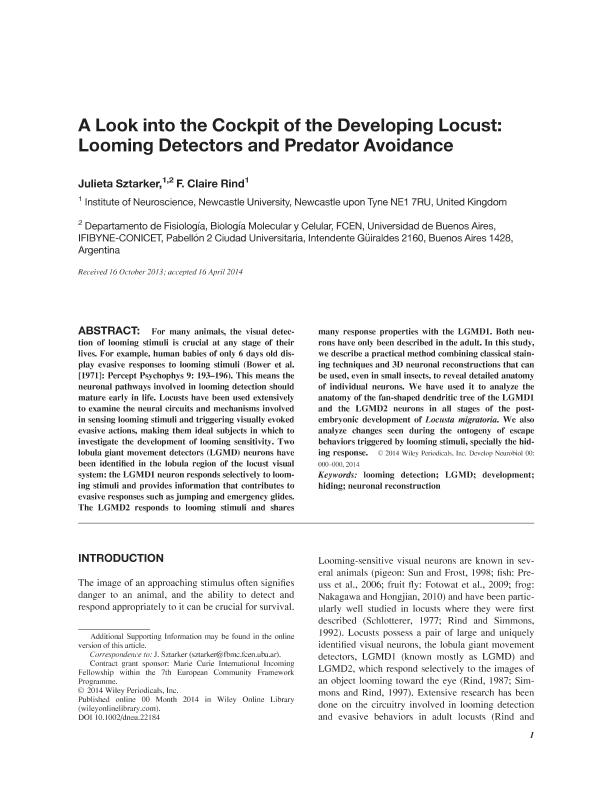Mostrar el registro sencillo del ítem
dc.contributor.author
Sztarker, Julieta

dc.contributor.author
Rind, F. Claire
dc.date.available
2019-10-01T18:00:34Z
dc.date.issued
2014-11
dc.identifier.citation
Sztarker, Julieta; Rind, F. Claire; A look into the cockpit of the developing locust: Looming detectors and predator avoidance; John Wiley & Sons Inc; Developmental Neurobiology; 74; 11; 11-2014; 1078-1095
dc.identifier.issn
1932-8451
dc.identifier.uri
http://hdl.handle.net/11336/84942
dc.description.abstract
For many animals, the visual detection of looming stimuli is crucial at any stage of their lives. For example, human babies of only 6 days old display evasive responses to looming stimuli (Bower et al. [1971]: Percept Psychophys 9: 193-196). This means the neuronal pathways involved in looming detection should mature early in life. Locusts have been used extensively to examine the neural circuits and mechanisms involved in sensing looming stimuli and triggering visually evoked evasive actions, making them ideal subjects in which to investigate the development of looming sensitivity. Two lobula giant movement detectors (LGMD) neurons have been identified in the lobula region of the locust visual system: the LGMD1 neuron responds selectively to looming stimuli and provides information that contributes to evasive responses such as jumping and emergency glides. The LGMD2 responds to looming stimuli and shares many response properties with the LGMD1. Both neurons have only been described in the adult. In this study, we describe a practical method combining classical staining techniques and 3D neuronal reconstructions that can be used, even in small insects, to reveal detailed anatomy of individual neurons. We have used it to analyze the anatomy of the fan-shaped dendritic tree of the LGMD1 and the LGMD2 neurons in all stages of the post-embryonic development of Locusta migratoria. We also analyze changes seen during the ontogeny of escape behaviors triggered by looming stimuli, specially the hiding response.
dc.format
application/pdf
dc.language.iso
eng
dc.publisher
John Wiley & Sons Inc

dc.rights
info:eu-repo/semantics/openAccess
dc.rights.uri
https://creativecommons.org/licenses/by-nc-sa/2.5/ar/
dc.subject
DEVELOPMENT
dc.subject
HIDING
dc.subject
LGMD
dc.subject
LOOMING DETECTION
dc.subject
NEURONAL RECONSTRUCTION
dc.subject.classification
Biología del Desarrollo

dc.subject.classification
Ciencias Biológicas

dc.subject.classification
CIENCIAS NATURALES Y EXACTAS

dc.title
A look into the cockpit of the developing locust: Looming detectors and predator avoidance
dc.type
info:eu-repo/semantics/article
dc.type
info:ar-repo/semantics/artículo
dc.type
info:eu-repo/semantics/publishedVersion
dc.date.updated
2019-09-30T18:51:42Z
dc.journal.volume
74
dc.journal.number
11
dc.journal.pagination
1078-1095
dc.journal.pais
Estados Unidos

dc.description.fil
Fil: Sztarker, Julieta. Consejo Nacional de Investigaciones Científicas y Técnicas. Oficina de Coordinación Administrativa Ciudad Universitaria. Instituto de Fisiología, Biología Molecular y Neurociencias. Universidad de Buenos Aires. Facultad de Ciencias Exactas y Naturales. Instituto de Fisiología, Biología Molecular y Neurociencias; Argentina. Universidad de Buenos Aires. Facultad de Ciencias Exactas y Naturales. Departamento de Fisiología, Biología Molecular y Celular; Argentina. University of Newcastle; Reino Unido
dc.description.fil
Fil: Rind, F. Claire. University of Newcastle; Reino Unido
dc.journal.title
Developmental Neurobiology

dc.relation.alternativeid
info:eu-repo/semantics/altIdentifier/url/https://onlinelibrary.wiley.com/doi/abs/10.1002/dneu.22184
dc.relation.alternativeid
info:eu-repo/semantics/altIdentifier/doi/https://doi.org/10.1002/dneu.22184
Archivos asociados
